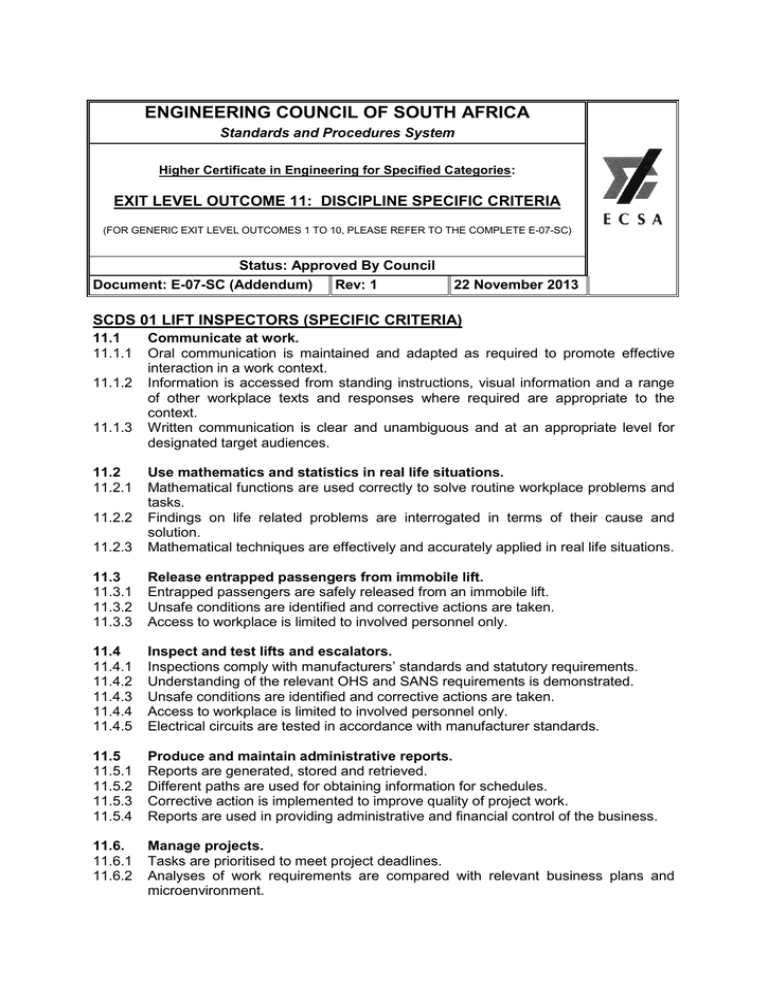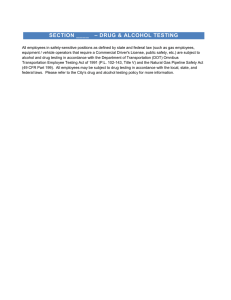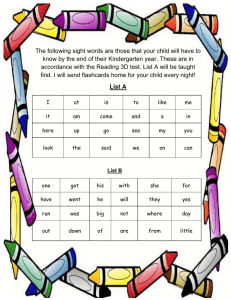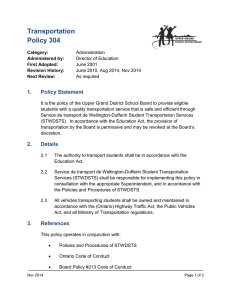Exit Level Outcome 11
advertisement

ENGINEERING COUNCIL OF SOUTH AFRICA Standards and Procedures System Higher Certificate in Engineering for Specified Categories: EXIT LEVEL OUTCOME 11: DISCIPLINE SPECIFIC CRITERIA (FOR GENERIC EXIT LEVEL OUTCOMES 1 TO 10, PLEASE REFER TO THE COMPLETE E-07-SC) Status: Approved By Council Document: E-07-SC (Addendum) Rev: 1 22 November 2013 SCDS 01 LIFT INSPECTORS (SPECIFIC CRITERIA) 11.1 11.1.1 11.1.2 11.1.3 11.2 11.2.1 Communicate at work. Oral communication is maintained and adapted as required to promote effective interaction in a work context. Information is accessed from standing instructions, visual information and a range of other workplace texts and responses where required are appropriate to the context. Written communication is clear and unambiguous and at an appropriate level for designated target audiences. 11.2.3 Use mathematics and statistics in real life situations. Mathematical functions are used correctly to solve routine workplace problems and tasks. Findings on life related problems are interrogated in terms of their cause and solution. Mathematical techniques are effectively and accurately applied in real life situations. 11.3 11.3.1 11.3.2 11.3.3 Release entrapped passengers from immobile lift. Entrapped passengers are safely released from an immobile lift. Unsafe conditions are identified and corrective actions are taken. Access to workplace is limited to involved personnel only. 11.4 11.4.1 11.4.2 11.4.3 11.4.4 11.4.5 Inspect and test lifts and escalators. Inspections comply with manufacturers’ standards and statutory requirements. Understanding of the relevant OHS and SANS requirements is demonstrated. Unsafe conditions are identified and corrective actions are taken. Access to workplace is limited to involved personnel only. Electrical circuits are tested in accordance with manufacturer standards. 11.5 11.5.1 11.5.2 11.5.3 11.5.4 Produce and maintain administrative reports. Reports are generated, stored and retrieved. Different paths are used for obtaining information for schedules. Corrective action is implemented to improve quality of project work. Reports are used in providing administrative and financial control of the business. 11.6. 11.6.1 11.6.2 Manage projects. Tasks are prioritised to meet project deadlines. Analyses of work requirements are compared with relevant business plans and microenvironment. 11.2.2 11.6.3 11.6.4 11.6.5 Potential risks that may affect project performance are recognised and appropriate actions are taken. Legislation that may impact on the work environment is identified and actions are taken to direct work activities to comply with the legislation. Requirements are ordered and procured in advance of being required. SCDS 02 LIFTING MACHINERY INSPECTORS (SPECIFIC CRITERIA) 11.1 11.1.1 11.1.2 11.1.3 11.1.4 Communicate in the workplace Reports are generated from available data Data is presented in accordance with the relevant needs of target audiences Oral communication is suited to the work context. Written communication is clear and unambiguous and at an appropriate level for designated target audiences. 11.2 11.2.1 11.2.2 11.2.3 11.2.4 11.2.5 11.2.6 11.2.7 Compile and maintain work schedules Scheduling is described in terms of its purpose and process Project activities are defined in terms of the required project outcomes Project plans are compiled in terms of identified activities Activities are sequenced in terms of workflow and timelines Activities are reported on in accordance with workplace requirements Paperwork is recorded and stored in accordance with workplace requirements Work activities are completed in accordance with agreed timeframes and efficiency 11.3 11.3.1 11.3.2 11.3.3 Apply engineering skills to the workplace Flow characteristics are explained in terms of engineering principles Measurement of flow is explained in terms of fluid principles Ferrous and non-ferrous metals are explained in terms of their properties and uses Ferrous and non-ferrous alloys are explained in terms of their properties and uses Thermo plastics and thermosetting plastics are explained in terms of their properties and uses Machining principles are explained in terms of functions and accuracy Work functions are explained in terms of quality in engineering practice Engineering risks are identified in terms of the potential impact for each risk on the project Actions to improve work functions are identified and analysed in terms of available options Recommendations are communicated to relevant personnel in accordance with workplace requirements 11.3.4 11.3.5 11.3.6 11.3.7 11.3.8 11.3.9 11.3.10 11.4 11.4.1 11.4.2 11.4.3 11.4.4 11.5 Range: Comply with relevant legislation in the workplace Legislation relevant to the work activities is identified and accessed in accordance with workplace requirements Legislation is interpreted in terms of the applicability to required work activities The implications of non-compliance with legislation is explained in terms of work processes and penalties Compliance reports are generated in terms of work activities Inspect lifting machinery and equipment Candidates will be assessed against lifting tackle and at least one of the following categories: Chain blocks and lever hoists Forklifts Mobile cranes Overhead and gantry cranes Tower cranes 11.5.1 11.5.2 11.5.3 11.5.4 11.5.5 11.5.6 11.5.7 11.5.8 11.5.9 11.5.10 11.5.11 11.5.12 Ships cranes Wharf side cranes Reach stackers Straddle carriers Container cranes Aerial platforms Suspended access platforms Industrial lifting devices Under the hook non-fixed attachments Tail lifters Vehicle hoists Other specialisation categories Inspection activities are planned in accordance with the inspection required and the workplace requirements The purpose of conducting various tests is explained in terms of relevant legislation and user safety standards Inspection and testing equipment selected is appropriate to the inspection required Authorisation to conduct inspection activities is obtained in accordance with workplace procedures The work area is prepared for the relevant inspection in accordance with inspection requirements Defects and potentially hazardous conditions are identified and corrected in accordance with workplace requirements Public access to the worksite is restricted in accordance with statutory requirements and worksite procedures Machinery and equipment is inspected and tested in accordance with test schedules and relevant safety standards Deviances from acceptable standards are identified and reported to the relevant stakeholder in accordance with statutory requirements and manufacturer specifications The consequences of omitting any part of the inspection and testing schedule are explained in terms of potential risks and liability The worksite is cleared, secured and restored to a safe and serviceable condition in accordance with statutory and worksite requirements Work activities are completed within agreed timeframes. The importance of completing activities in these timeframes is explained in terms of customer service and work interruptions SCDS 03 MEDICAL EQUIPMENT MAINTAINERS (SPECIFIC CRITERIA) 11.1 11.1.1 11.1.2 11.1.3 11.1.4 11.1.5 11.1.6 11.1.7 11.2 Range: 11.2.1 11.2.2 11.2.3 11.2.4 11.2.5 11.2.6 11.2.7 11.2.8 11.2.9 11.3 11.3.1 11.3.2 11.3.3 11.3.4 11.3.5 11.3.6 Apply problem solving skills to maintain medical equipment Variances from medical equipment specifications are identified in a methodical manner that includes all areas of performance. Causes of faults are identified and actions taken, to prevent similar problems in the future, are appropriate to the symptoms. The operation of machines is described in terms of the process of enhancing human performance. Alternative solutions to problems are identified that provide similar results. Solutions identified are efficient in terms of cost, time and reliability. Logical procedures are followed to correct all identified variances. Variances are corrected in accordance with recognised clinical engineering procedures or codes of practice. Maintain medical equipment Candidates will be assessed against at least one of the following categories: Mechanical equipment Electro-medical equipment Respiratory and anaesthesia equipment Medical imaging equipment Other relevant equipment (specify) Application and operation of medical equipment are described in the clinical environment. Policies for maintenance work are sourced and confirmed for applicability with relevant sources. The work area is prepared for the relevant activities in accordance with workplace requirements. Defects are identified from user reports and test procedures. Tools and test equipment used are appropriate to the type of medical equipment. Faults are identified through logical fault finding procedures. Medical equipment is repaired, maintained and calibrated in accordance with manufacturer specifications and relevant policies. Equipment performance and safety inspections are completed according to relevant check lists and specifications before returning equipment to use. Accurate equipment history is captured and recorded for future reference for a time period relevant to equipment type maintained and legal policies. Apply scientific and engineering skills to maintain medical equipment Work functions required in maintaining medical equipment are explained in terms of quality in engineering practice. Engineering risks are identified in terms of the potential impact for each risk on safety and performance of medical equipment. Actions to improve work functions are identified and analysed in terms of available options. Different types of materials used in medical equipment are explained in terms of their properties and potential uses. Fabrication principles for fabrication of required components are explained in terms of functions and accuracy. Electrical circuits are tested and repaired in accordance with manufacturer specifications. 11.3.7 11.3.8 11.4 11.4.1 11.4.2 11.4.3 11.4.4 11.4.5 11.5 11.5.1 11.5.2 11.5.3 11.5.4 11.5.5 11.5.6 11.6 11.6.1 11.6.2 11.6.3 11.6.4 Flow characteristics are explained in terms of engineering principles related to the medical equipment to be maintained. Measurements and related procedures are explained in engineering terms. Communicate maintenance information for medical equipment Maintenance reports are generated from relevant data in accordance with workplace procedures. Information included in the report is in accordance with the relevant needs of target audiences. Documents and recommendations are generated in accordance with workplace requirements. Methods of communicating maintenance information are suited to the work context. Communication is clear, unambiguous and at an appropriate level for designated target audiences. Comply with relevant legislation in maintaining medical equipment Medical equipment maintenance activities are planned in accordance with workplace legislative requirements. Authorisation to conduct activities is obtained in accordance with workplace procedures. Potentially hazardous conditions are identified and reported in accordance with workplace requirements. Deviances from acceptable standards are identified and reported to the relevant stakeholder in accordance with statutory requirements and manufacturer specifications. The consequences of omitting procedures are explained in terms of potential risks and liability. Maintenance activities are completed within agreed timeframes. The importance of completing activities in these timeframes is explained in terms of customer service and work interruptions. Comply with accepted work ethics and good practice when maintaining medical equipment Professional conduct is explained in accordance with relevant acts, codes of conduct and practice as it relates to maintaining medical equipment. Maintenance of medical equipment is conducted in accordance with relevant acts. Recognised clinical engineering principles are adhered to in order to preserve patient and public safety. Range: Clinical engineering principles include all aspects of making equipment safe for the operator and patient. Maintenance tasks are conducted economically and safely. SCDS 04 FIRE PROTECTION SYSTEMS INSPECTORS (SPECIFIC CRITERIA) Range of Systems: a) Fire alarm and detection b) Passive fire protection c) Aerosol fire extinguishing d) Water sprinkler e) Powder fire extinguishing f) Foam fire extinguishing g) Electrical smoke control h) Mechanical smoke control i) Mechanical fixed gaseous fire extinguishing, and j) Electrical fixed gaseous fire extinguishing 11.1 11.1.1 11.1.2 11.1.3 11.1.4 11.1.5 11.2 11.2.1 11.2.2 11.2.3 11.2.4 11.3 11.3.1 11.3.2 11.3.3 11.3.4 11.3.5 11.3.6 11.3.7 11.4 11.4.1 Installation: Demonstrate knowledge of the components of the equipment to be installed The basic chemistry of combustion is described in accordance with accepted fire industry standards Components are identified and the purpose of each component is described in terms of its main uses and limitations in the system Consequences of incorrect installation are explained in terms of the effect on the system Different fire risk zones or occupancy classifications are described in accordance with the relevant SANS standards. (For smoke control systems only, the interconnections between smoke control and other fire protection measures are explained in relation to their importance). Static electricity is described in terms of the risks involved and precautionary measures that may be taken. (Not applicable to smoke control systems). Installation: Prepare to install components making up the installation Building plans (for aerosol extinguishing, equipment only) and schematic diagrams are interpreted to identify location of components. Tools, equipment and components required for the installation are identified and prepared for use in accordance with the given design The installation task is confirmed with relevant authorities in accordance with workplace procedures Permission to install the system is confirmed with relevant personnel in accordance with relevant safety legislation Installation: Install the components making up the system Components are installed in accordance with manufacturer specifications Components are positioned in accordance with contract documentation Cables are installed in accordance with the relevant SANS standard. For water sprinkler, powder, foam and fixed gaseous systems pipes are used in accordance with the relevant legislation. Work is conducted in accordance with relevant health and safety legislation Work is conducted in accordance with agreed time schedules Tools and equipment are used in accordance with their design Power supply circuit breakers are labelled in accordance with health and safety legislation (Not applicable to fixed gaseous fire extinguishers). Installation: Test the system Continuity of wiring and piping where applicable is/are checked in accordance with manufacturer specifications 11.4.2 11.4.3 11.4.4 Test equipment is used in accordance with its design Work is conducted in accordance with relevant health and safety legislation Relevant documentation is completed in accordance with legislative requirements 11.5 11.5.1 Commissioning: Demonstrate knowledge of commissioning of systems The purpose of commissioning the system is explained in terms of meeting client acceptance criteria Limitations to commissioning are described in accordance with relevant health and safety legislation Test methods are described in accordance with the relevant legislation/standard (Not applicable to smoke control systems). Cross-zoning of detection zones is described in relation to the effect on the particular extinguishing systems. (Not applicable to passive, water sprinkler, and mechanical fixed gaseous fire protection systems). The link between detection (or extinguishing) and ancillary (or protection) systems is explained in relation to design criteria. (Not applicable to mechanical gaseous systems). Consequences of non-compliance of the system are explained in terms of the potential impact to safety and loss control 11.5.2 11.5.3 11.5.4 11.5.5 11.5.6 11.6 11.6.1 11.6.2 11.6.3 11.6.4 11.6.5 11.7 11.7.1 11.7.2 11.7.3 11.7.4 11.8 11.8.1 11.8.2 11.8.3 11.8.4 Commissioning: Activate and test systems The system is initialised and checked for operation in accordance with design criteria Operation of ancillary devices are confirmed to be in accordance with design criteria Faults are rectified in accordance with manufacturer specifications Information for an addressable system is obtained from the client and entered into the control panel in accordance with manufacturer specifications Test equipment is used in accordance with its design Commissioning: Inspect systems The installation is confirmed to be in accordance with the building plans The installation is checked for conformance to the schematic drawings The power (or water for sprinklers) supply is confirmed to be correct in accordance with design criteria. (Not applicable to mechanical gaseous). The system is confirmed to meet engineering and safety requirements Commissioning: Certify systems The system is confirmed to be in accordance with the design Relevant documentation is completed in accordance with legislative requirements Documentation is distributed in accordance with legislative requirements The end user is briefed on the operation of the system in accordance with system requirements and user responsibilities 11.9 11.9.1 Maintenance: Demonstrate knowledge of maintaining the system 11.9.2 Different systems (listed in Range of Systems above) are described in terms of their main functions and maintenance procedures or For smoke control systems, the interconnection between different systems is described in terms of their importance in fire protection 11.9.2a Different types of power supply systems (or water sprinkler supply, or fixed gaseous) are identified and described in terms of their applicability to the system 11.9.3 11.9.4 11.9.5 11.10 11.10.1 11.10.2 11.10.2a 11.10.2b 11.10.3 11.10.4 11.10.5 11.11 11.11.1 11.11.2 11.11.3 11.11.4 11.12 11.12.1 11.12.2 11.12.3 11.12.4 Maintenance tasks and relevant equipment are described in accordance with accepted industry standards Maintenance intervals are identified in accordance with manufacturer specifications Safety requirements are described as they relate to specific zones Maintenance: Test the particular system The functionality of components and ancillary devices are confirmed to be in accordance with design criteria The power (water, in case of sprinklers) supply system is tested in accordance with manufacturer specifications. (Not applicable to mechanical fixed gaseous systems) or For smoke control systems, the pneumatic system is tested in accordance with accepted codes of practice or For smoke control systems, interconnection with other fire protection systems are tested in accordance with manufacturers specifications Tests are conducted without causing damage to property or equipment Work is conducted in accordance with legislative safety requirements The system is confirmed to be operational in accordance with design criteria Maintenance: Repair the particular system Faults with the system are identified and repaired or reported in accordance with design criteria Replacement components are identified in terms of applicability and availability Components are replaced in accordance with manufacturer specifications Recommendations are made in relation to additions and rectifications Maintenance: Report on maintenance procedures The system is confirmed to be in accordance with the design Relevant documentation is completed in accordance with legislative requirements Documentation is distributed in accordance with legislative requirements The end user is briefed on the operation of the system in accordance with system requirements and user responsibilities Revision History Version Date Draft 1 22 July 2013 Draft 2 12 September 2013 Revision Authorized by SGG Specified Category SGG Specified Categories Nature of revision Original draft. Input from JIC and CRC incorporated. Approved by SGG Specified Categories Committee.


